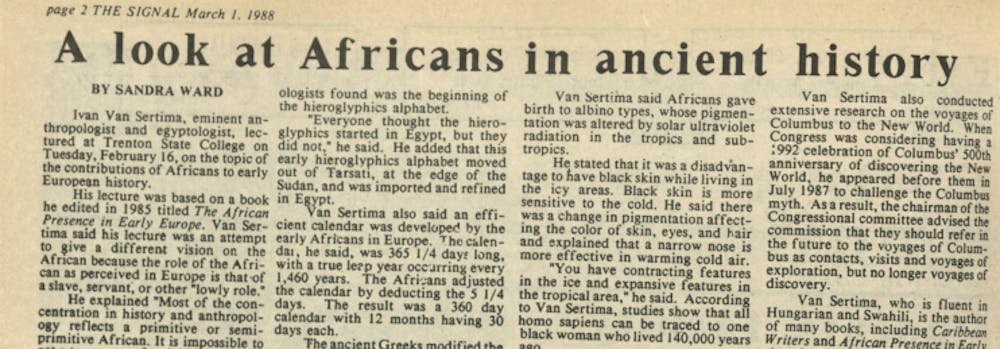Every week, Features Editor Lily Firth hits the archives and finds old Signals that relate to current College topics and top stories.
During the month of February, we celebrate the contributions black Americans have made to our society, and how they persevered through a traumatic history of oppression. In 1998, an African-American scholar lectured at the College to inform students about achievements of Africans throughout time in honor of Black History Month.

Ivan Van Sertima, eminent anthropologist and Egyptologist, lectured at Trenton State College on Tuesday, February 16, on the topic of the contributions of Africans to early European history.
His lecture was based on a book he edited in 1985 titled “The African Presence in Early Europe.” Van Sertima said his lecture was an attempt to give a different vision on the African because the role of the African as perceived in Europe is that-of a slave, servant or other “lowly role.”
He explained, “most of the concentration in history and anthropology reflects a primitive or semiprimitive African. It is impossible to get a true sense of a civilization or an accomplishment and achievement of a people by focusing on their least important aspects.”
Van Sertima went on to state quite emphatically that the African people were responsible for all the major elements, both political and religious, that were to become important in the later dynasties. One of the more remarkable things the archaeologists found was the beginning of the hieroglyphics alphabet.
Van Sertima also said an efficient calendar was developed by the early Africans in Europe. The Africans adjusted the calendar by deducting the 5 1/4 days. The result was a 360-day calendar with 12 months having 30 days each.
Studies from Oxford University, the University of Hawaii and the University of California at Berkeley revealed that the first of man’s direct ancestors was born in Africa. According to Van Sertima, that is not new information.
“What is new information,” he said “is that of the six stages of man, the last stage in the evolution of man, homo sapiens, has been found in Africa. As a matter of fact, evidence shows that the last stage of man moved out of Africa to Europe and Asia.” The studies also revealed that about 55,000 years ago the pigmentless, Caucasian type of homo sapiens emerged from the African race.
Van Sertima said Africans gave birth to albino types, whose pigmentation was altered by solar ultraviolet radiation in the tropics and subtropics.
He stated that it was a disadvantage to have black skin while living in the icy areas. Black skin is more sensitive to the cold. He said there was a change in pigmentation affecting the color of skin, eyes and hair and explained that a narrow nose is more effective in warming cold air.
“You have contracting features in the ice and expansive features in the tropical area,” he said. According to Van Sertima, studies show that all homo sapiens can be traced to one black woman who lived 140,000 years ago.
Van Sertima, who is fluent in Hungarian and Swahili, is the author of many books, including Caribbean writers and African Presence in Early Americans.







